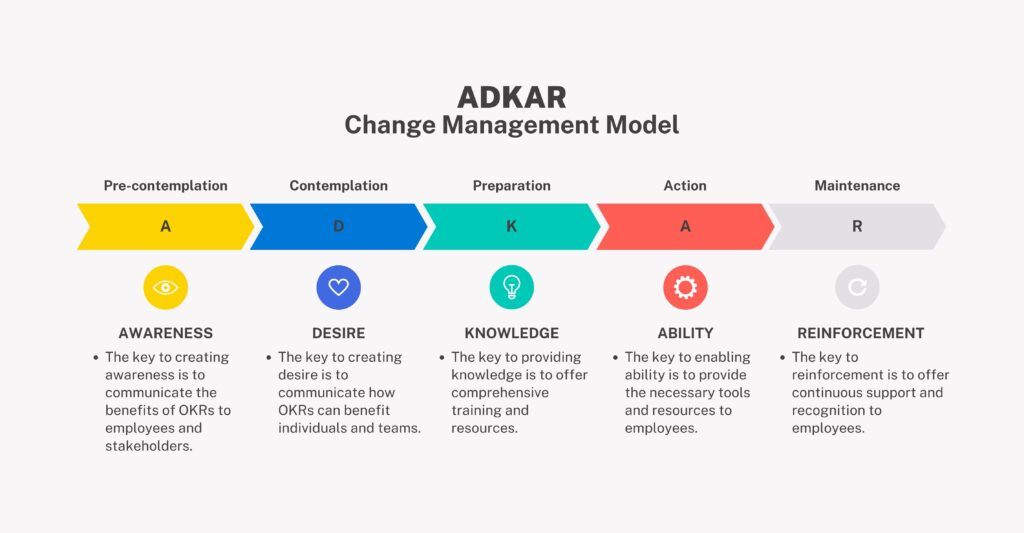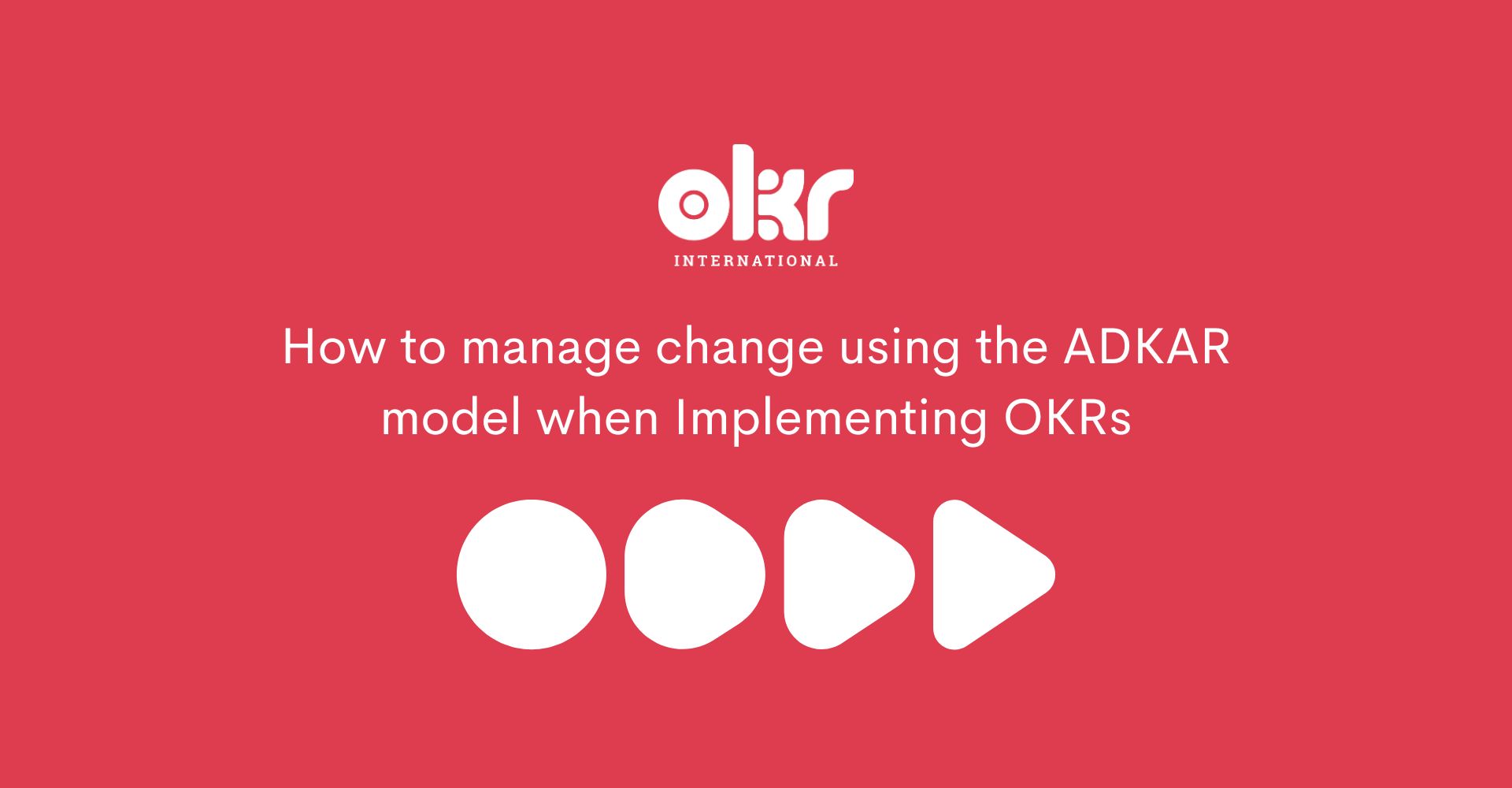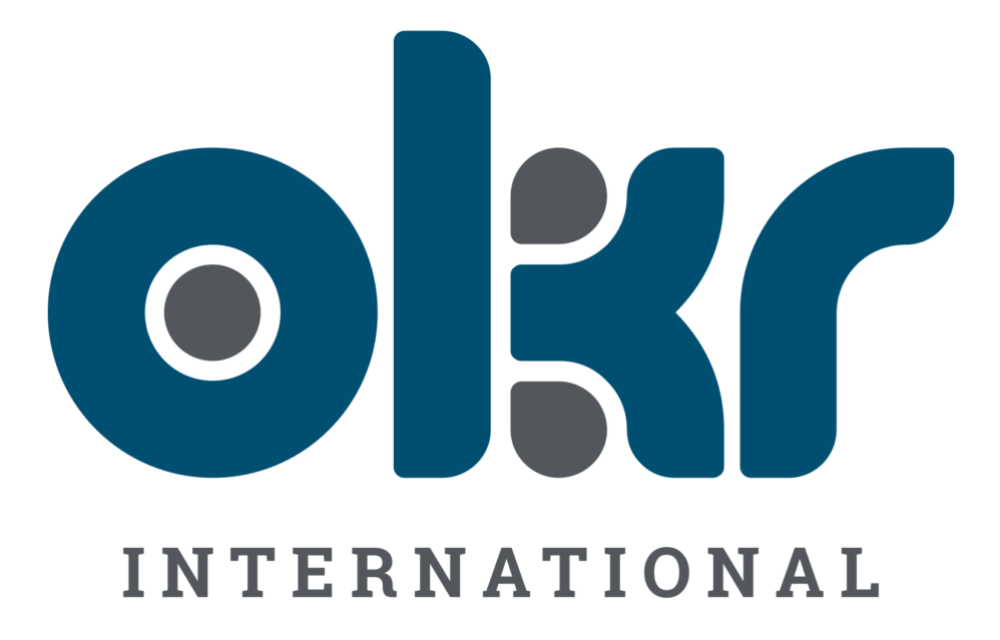How to manage change using the ADKAR model when Implementing OKRs
Introduction
OKR (Objectives and Key Results) is a powerful framework for setting and tracking objectives throughout an organization, but its implementation goes far beyond simply adopting a new piece of software. Implementing OKRs is a transformative process that requires a deep understanding of organizational culture and a commitment to change management.
One of the most important things to understand about OKRs is that they are not just a tool; they are a mindset. They require a shift in how an organization sets goals, measures success, and views failure. This cultural shift cannot be achieved through technology alone. It requires clear communication, consistent reinforcement, and strong leadership.
Moreover, OKRs are not a one-size-fits-all solution. They need to be tailored to the specific needs, culture, and strategic objectives of each organization. This customization process is not something that software can do on its own. It requires deep understanding of the organization’s strategy and the ability to translate that strategy into meaningful, measurable objectives.
Change management is the secret ingredient that makes OKR implementation successful. It ensures that the adoption of OKRs is not just a top-down mandate, but a cultural shift that is embraced at all levels of the organization. Effective change management involves clear communication about why the change is happening, what the benefits are, and how it will affect everyone’s work. It also involves providing training and support to help people adapt to the new way of setting and tracking goals.
In this article, we’ll delve into a powerful tool that can assist organizations in effectively managing change – the ADKAR model for change management when implementing OKRs. If you’re a leader looking to implement a new strategy or an employee tasked with implementing a new process, this article is for you. We’ll explore the ADKAR model for change management in-depth and show you how to combine it with OKRs to drive performance and growth. So, let’s get started, shall we?
What is the ADKAR Model?
The ADKAR model is a change management framework that helps organizations successfully implement change. This methodology was developed by Jeff Hiatt, the founder of Prosci, a leading provider of change management resources. It is a five-step process that focuses on helping individuals understand the need for change, develop a desire to change, acquire the knowledge and skills necessary to make the change, and implement the change on a permanent basis.
Implementing OKRs with the ADKAR Model

1. Awareness
The first stage of the ADKAR model is Awareness. This stage involves creating awareness about the need for change and how OKRs can help achieve organizational goals. The key to creating awareness is to communicate the benefits of OKRs to employees and stakeholders. This can be done through various channels such as town hall meetings, internal communications, or training sessions.
Case of TechFinity
Consider the case of TechFinity, a global technology company, had been experiencing a lack of alignment between its various departments and teams. This was resulting in missed deadlines, miscommunication, and a general lack of synergy that was starting to impact their productivity and bottom line. After an internal review, the leadership team concluded that they needed a new way to align their teams and their objectives. They decided to implement the OKR (Objectives and Key Results) methodology.
In order to raise awareness about this shift, TechFinity’s CEO, Jane, started with an all-hands town hall meeting. Jane outlined the challenges the company had been facing and how these were impacting the business and its ability to innovate and stay competitive in the tech industry. She then introduced the concept of OKRs, explaining how this approach would bring much-needed alignment and focus, enabling the company to execute its strategy more effectively.
In addition to the town hall meeting, Jane and her leadership team launched an internal communications campaign. This included informative emails, articles, and videos about OKRs, all shared via the company intranet. They also organized several Q&A sessions where employees could ask their questions and express their concerns about the upcoming changes.
Through these actions, TechFinity was able to create a company-wide understanding of the benefits of OKRs and the reasons behind their adoption, setting the stage for the next steps of the ADKAR model. The emphasis was on explaining the ‘why’ behind the change, and this clear communication helped to alleviate potential resistance and build a solid foundation for the adoption of the OKR methodology.
2. Desire
This stage involves creating a desire for change and OKRs among employees and stakeholders. The key to creating desire is to communicate how OKRs can benefit individuals and teams. This can be done by highlighting how OKRs can help employees achieve their personal goals and contribute to the success of the organization.
Case of TechFinity
Jane understood that for the transition to be successful, it was crucial to link the benefits of OKRs to the personal and professional growth of employees. She started by engaging with her CXO team and team leaders and managers, discussing how OKRs could help them lead their teams more effectively and achieve their personal leadership goals. She also invited her CXO team (Direct Reports) to initiate similar conversations with their respective teams.
She explained that OKRs can provide clarity, giving each employee a clear understanding of what they need to achieve and how it aligns with the company’s objectives. This would help eliminate ambiguity and increase the efficiency of every team. Jane also emphasized that OKRs encourage risk-taking and innovation—core values at TechFinity—by focusing on ambitious goals and viewing failure as an opportunity for learning.
To further create desire, Jane and her team launched an “OKR Champions” program. This program enlisted enthusiastic early adopters who were trained in the OKR methodology. These champions would then mentor their peers, spreading their excitement and sharing success stories about how OKRs had improved their own work.
Jane also made sure to tie the adoption of OKRs to the company’s larger mission and values. She highlighted how OKRs could accelerate the company’s vision to be a global leader in technology solutions. By showing how OKRs directly contributed to the company’s mission and the employees’ role in that mission, Jane was able to create a strong desire among employees to adopt OKRs.
The combination of these efforts helped instilled a genuine desire for change within TechFinity. Employees started to see the value of OKRs not just for the company, but for their own growth and achievement. They started to understand that embracing OKRs meant contributing more effectively to the company’s mission and enhancing their own professional development.
3. Knowledge
This stage involves providing employees and stakeholders with the knowledge they need to adopt OKRs successfully. The key to providing knowledge is to offer comprehensive training and resources. This can be done through e-learning modules, workshops, or coaching sessions.
Case of TechFinity
Having established a strong understanding and desire for OKRs within TechFinity, Jane shifted her focus to the Knowledge stage of the ADKAR model. She understood that for the OKR methodology to be successfully implemented, employees needed to be equipped with the necessary knowledge and skills.
Jane’s team invited an expert OKR partner to train her and her teams on OKRs. This program included a series of learning modules that explained the basics of OKRs, how to write effective objectives and key results, and how to track progress. The modules were designed to be interactive and engaging, allowing employees to learn at their own pace.
In addition to training sessions, Jane organized OKR workshops. These workshops were led by experienced external OKR coaches. They provided a more hands-on experience where employees could practice writing and reviewing OKRs in a collaborative setting. They also served as a platform for employees to ask questions and share their experiences.
To complement these learning opportunities, Jane’s team created a resource hub on the company intranet. This hub included FAQs, guides, templates, and case studies from other organizations that had successfully implemented OKRs. The hub was continuously updated with new resources and best practices.
Jane also encouraged a culture of continuous learning. She instituted regular feedback sessions where teams could review their OKRs, discuss what was working and what wasn’t, and learn from each other’s experiences. This ensured that learning and improvement was an ongoing process, not just a one-time event.
Through these measures, Jane ensured that every employee at TechFinity had the knowledge and resources necessary to adopt OKRs. This not only prepared them for the change but also built confidence in their ability to navigate this new way of working.
4. Ability
This stage involves enabling employees and stakeholders to implement OKRs effectively. The key to enabling ability is to provide the necessary tools and resources to employees. This can be done by offering software tools, templates, or dashboards that can help employees track and monitor their OKRs.
Case of TechFinity
Now that the employees at TechFinity were equipped with the knowledge about OKRs, Jane turned her attention to the Ability stage of the ADKAR model. She knew that having the knowledge was not enough; the employees needed to have the ability to put their knowledge into practice effectively.
To facilitate this, Jane initiated the introduction of an OKR software platform. This platform would allow every team and individual to input their OKRs, track their progress, and see how their objectives aligned with the company’s overarching goals. The software also included features for feedback and collaboration, enabling teams to work together on their OKRs and provide real-time updates.
Jane also made sure that comprehensive training was provided on how to use this new software. This was done through a combination of online tutorials, live demos, and hands-on training sessions. She wanted to ensure that all employees were comfortable using the platform and felt confident in their ability to track and monitor their OKRs.
In addition to the software, Jane’s team provided a variety of resources to support employees’ ability to implement OKRs. This included templates for writing OKRs, guides for conducting OKR review meetings, and dashboards for monitoring progress at both team and organizational levels.
Moreover, Jane promoted a culture of ongoing support. This meant that help was always available for anyone struggling with the OKR process. The OKR Champions were there to provide guidance and support, and regular check-ins were scheduled to address any issues or challenges.
Through these initiatives, Jane was able to ensure that everyone at TechFinity not only had the knowledge to use OKRs, but also the ability to put that knowledge into practice. This was a critical step in making sure that the adoption of OKRs would be successful and sustainable.
5. Reinforcement
In this stage, individuals are provided with ongoing support to ensure that the change is sustained. This stage involves reinforcing the adoption of OKRs and ensuring that they become a part of the organization’s culture. The key to reinforcement is to offer continuous support and recognition to employees. This can be done by recognizing employees who have achieved their OKRs or by incorporating OKRs into performance reviews.
Case of TechFinity
With the employees at TechFinity now having the knowledge and ability to effectively implement OKRs, Jane’s attention turned to the final stage of the ADKAR model: Reinforcement. She knew that sustaining the change would require constant reinforcement and support.
To start, Jane decided to incorporate OKRs into the company’s performance review process. This meant that employees’ success in achieving their OKRs, as well as their engagement with the OKR process, became a part of their performance assessment. This not only reinforced the importance of OKRs but also incentivized employees to fully engage with the process.
Jane also implemented a recognition program, where teams and individuals who achieved their OKRs or demonstrated exceptional commitment to the OKR process were celebrated. This could be through shout-outs in company meetings, features in the company newsletter, or even small rewards. By recognizing these achievements, Jane was able to highlight the benefits of OKRs and encourage others to engage more deeply with the process.
Furthermore, Jane kept the lines of communication open. She organized regular OKR review meetings where teams could share their progress, discuss challenges, and learn from each other. These meetings served as a platform for ongoing learning and improvement, reinforcing the idea that working with OKRs is a continuous journey.
Jane also ensured that support was always available for those who needed it. Whether it was additional training, resources, or just a listening ear, Jane made sure that every employee felt supported in their OKR journey.
Through these reinforcement strategies, Jane was able to embed OKRs into the culture of TechFinity. The OKR methodology became more than just a tool; it became a way of thinking and working that drove alignment, encouraged innovation, and helped TechFinity to achieve its strategic goals.
Conclusion
The ADKAR model—Awareness, Desire, Knowledge, Ability, and Reinforcement—is a powerful framework for managing and understanding change at an individual level. However, while the model is presented in a linear way, the reality of change is often non-linear. This means that individuals may not progress through the stages in a straight line, and they may need to revisit earlier stages as they move through the change process.
In the context of implementing the OKR (Objectives and Key Results) methodology, this non-linear nature could manifest in several ways.
For example, an employee might reach the Ability stage, where they have the skills to implement OKRs, but then something might happen that makes them question the need for change—perhaps a failed OKR or a shift in company strategy. This could send them back to the Awareness or Desire stages, where they need to reestablish the reasons for the change and their personal motivation to engage with it.
Or, an employee might have the Desire to adopt OKRs, but when they reach the Knowledge stage, they realize that they don’t fully understand how to write effective OKRs. This could send them back to the Awareness stage, where they need to deepen their understanding of what OKRs are and why they’re important.
The key to navigating this non-linear process is to understand that it’s normal and to be prepared for it. Change is complex and rarely follows a straight line. It’s important to provide ongoing support and resources at all stages of the ADKAR model and to be ready to revisit earlier stages as needed.
This is where the Reinforcement stage becomes especially important. By providing continuous support, recognition, and opportunities for learning, you can help individuals navigate the complexities of change and ensure that the adoption of OKRs is successful and sustainable.
Remember, managing change is never easy, but with the right approach and the right tools, it can be a manageable process. By using the ADKAR principles for change management and OKRs, organizations can achieve their goals and drive performance and growth. So why not give it a try? Start implementing this methodology today and see the positive impact it can have on your organization. Good luck!
The Gold Standard in Agile Performance Management
Future workplaces need to thrive in a rapidly changing environment. An agile performance management system provides an organisation with the wireframe to prosper in a marketplace riddled with volatility, uncertainty, complexity and ambiguity.
- Integrate OKRs & Performance Management System
- Bridge the gap between strategy & execution
- Go beyond the traditional bell curve
- Increase employee engagement & productivity




